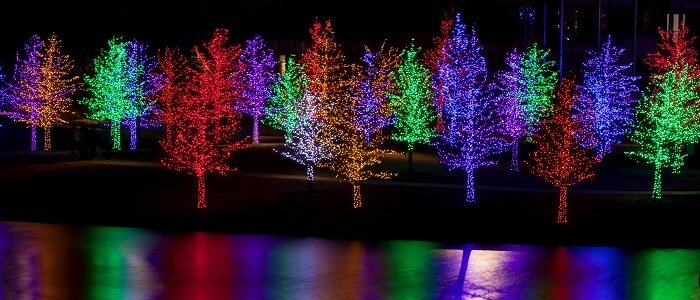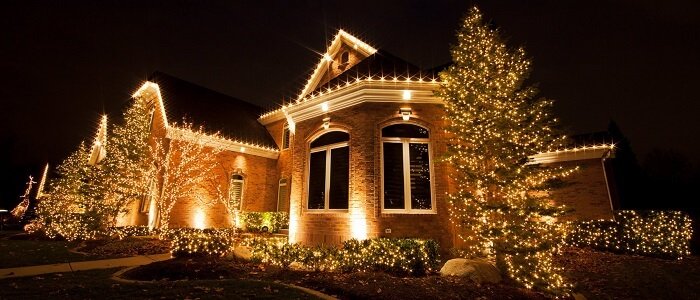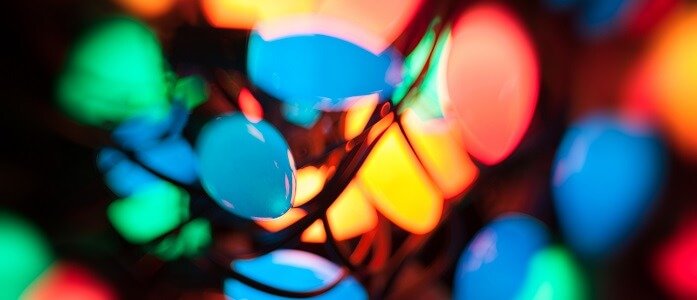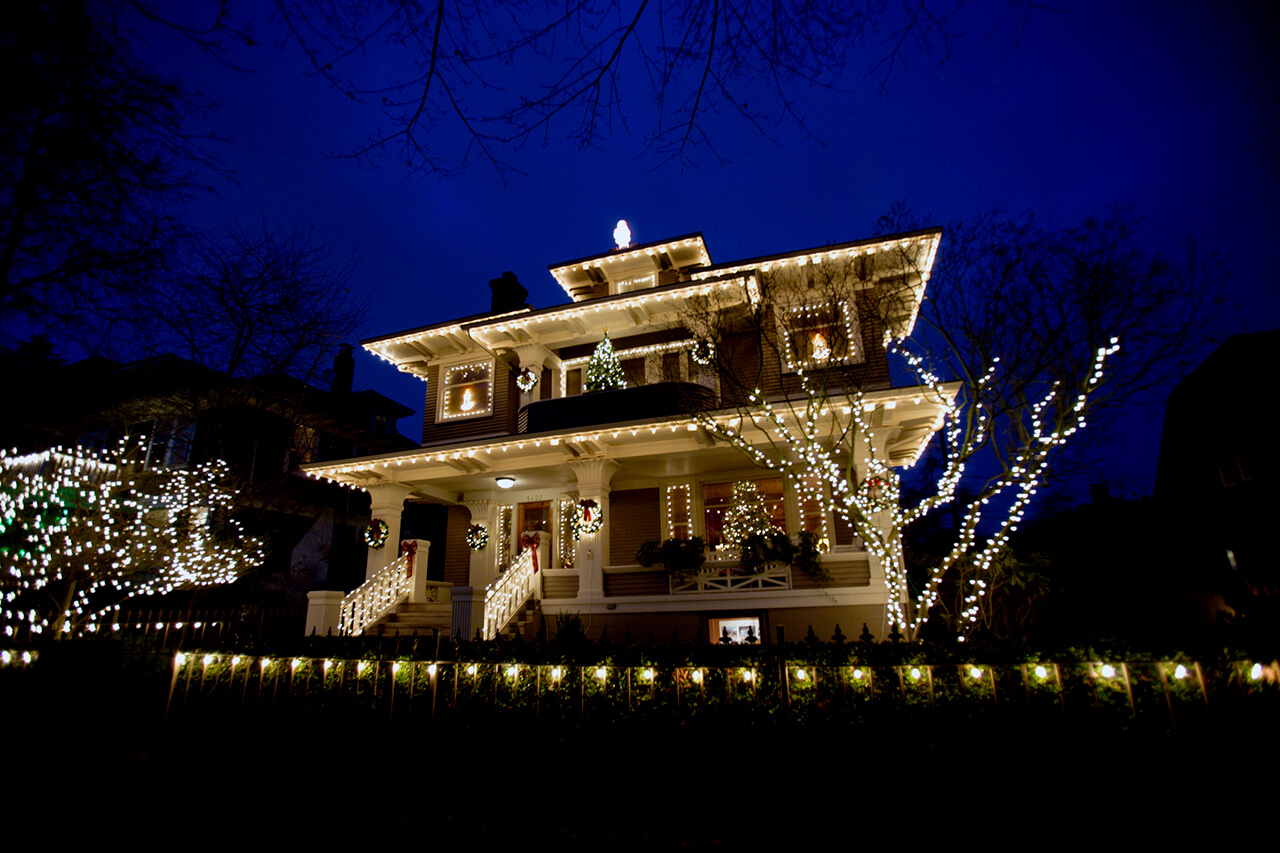How Much Does Professional Christmas Light Installation Cost?
Typical Range:
$219 - $686
Typical Range:
$219 - $686
Cost data is based on actual project costs as reported by 2,131 HomeAdvisor members. Embed this data
.
.
.
.
.
.
.
.
.
.
.
.
.
.
.
.
.
.
.
.
.
.
.
.
.
.
.
.
.
.
•
•
•
•
Updated November 28, 2022
Written by HomeAdvisor.Professional Christmas light installation costs $443 on average for exterior holiday lighting, with a typical range between $219 and $686. The light strands alone cost between $8 and $30 each. Installation adds another $120 to $500 to your budget. For multistory residential projects, the total price can go up to $1,500.
On Thanksgiving weekend, your neighborhood will start to light up with Christmas decorations. It brightens the lawns in the dead of winter and dresses up your home. Hiring a pro can turn your property into a showcase for the entire neighborhood while making sure the wiring and installation is safe.
Let's calculate cost data for you. Where are you located?
Where are you located?
| National Average | $443 |
| Typical Range | $219 - $686 |
| Low End - High End | $100 - $1,300 |
Cost data is based on actual project costs as reported by 2,131 HomeAdvisor members.
Most professional lighting installations range between $300 and $800 for labor alone. You can hire an individual by the hour at a rate between $60 and $100. Larger companies that bring their own lights offer packages that cost between $400 and $1,800 and include the strands, installation, and takedown.
Experts typically charge between $2 and $5 per linear foot. That includes all aspects of the installation, but not the lights themselves. A handyperson costs slightly less than a professional installer, but they don’t specialize in the process.
If you don't own your own holiday lighting, add another $0.50 to $2 per foot to that cost depending on the type of bulb you purchase. Clarify whether the per-foot quote includes takedown after the season as it’s sometimes an extra charge.
A small ranch home may only cost $250, while a multistory residence can range up to $1,800 for installation alone. Home size is one of the largest factors in the price of your holiday lighting installation. The more space you need to cover, the more money you’ll spend on both lights and labor.
| Home & Square Footage | Average Installation Price |
|---|---|
| One-story (ranch), 1,000 – 2,000 | $250 – $600 |
| One story (ranch), 2,000 – 3,500 | $300 – $750 |
| Two-story, 1,500 – 2,000 | $400 – $1,000 |
| Two-story, 2,500 – 3,500 | $500 – $1,200 |
| Three-story 2,500 – 4,000 | $700 – $1,800 |
| Home and property, 4,000+ | $500 – $1,800 |
Expect to pay $150 to $1,200, or about 20% above regular installation prices if you have a difficult-to-reach roof and eaves. The special equipment needed to reach your roof and eaves— like extended height ladders and scaffolding—increases the price. The initial quote should include any cost increase.
Budget $50 to $100 per hour plus a call-out fee of $25 to $75 inelectrician costs if you need to install new electrical wires for the lights. Most installation pros won't install outlets or ground outdoor wires, though they do provide extension cords and stakes to keep lighting in place. Installing an outlet costs around $220, so it's an affordable addition if you decide you need an extra outlet or want a dedicated Christmas light outlet.
You may choose to use timers for your holiday lights, which cost $10 to $30 each. Some wreaths come with small battery packs to keep them illuminated without a cord to trip over. Some lighting may also work with battery power. Discuss options with your pro.
On average, permanent holiday lights cost around $3,500 to install. You may save a little if you wrap the price into your outdoor lighting costs during an exterior living upgrade. In exchange, you get decorations that last for years. The only additional price will be replacing your LED bulbs every four to six years. Permanent installation might mean installing an exterior electrical socket for decorating the trees. Remember, though: Permanent pricing doesn’t include exterior electrical socket costs.
Most Christmas lights now are LEDs, which cost only slightly more than incandescents, but are far more cost-effective to run each month. Christmas light prices run $0.50 to $2 per linear foot when purchased as part of the installation, or between $4 and $30 per strand when you buy them at a holiday decoration or home improvement store.
Most strands feature 100 to 200 bulbs.
Expect to use 10 to 20 strands to cover an average-sized home between 1,000 and 2,000 square feet.
Lighting options range from standard lights to LED lighting, dome bulbs, and incandescent C bulb alternatives.
| Christmas Light Type | Christmas Light Price per 25 ft. Strand |
|---|---|
| Dome | $6 – $15 |
| Incandescent | $5 – $20 |
| LED | $13 – $60 |
| C3 | $12 – $35 |
| C5 | $15 – $40 |
| C6 | $17 – $40 |
| C7 | $16 – $80 |
| C9 | $15 – $70 |
Expect to pay between $5 and $30 per incandescent strand. This is the traditional but less common choice with the growing popularity of LED lighting. Incandescent bulbs cost about $300 to $500 per month to run with a large display. They cost the least up front, but about 10 to 20 times as much to run as an LED. They also burn out quickly.
LED bulbs average $13 to $20 per 25-foot strand. They typically last longer than other types and are brighter. They also use less electricity, making them more energy efficient. However, LEDs are more expensive and will raise your installation costs.
Dome lights by Mr. Handyman of Charleston, Summerville, SC. Christmas light installation in South Carolina averages $250 to $515.
Dome bulbs are smaller and round, ranging from $6 to $15 per 25-foot strand. They give off a soft, widespread light and come in a variety of colors. Use them for landscape lighting and other spaces in which the focus is on brightening a larger area.
The price of C style lights, which include C3, C6, C7, and C9, runs $17 to $70 per 25-foot strand (with the high end comprising Bluetooth/app syncing technology). These bulbs are larger and put an especially bright emphasis on your home or landscape. Individual strands are as long as the other options above, but you get fewer lights per strand in comparison.
For commercial-grade Christmas light installation, including the cost of the lights themselves, expect to pay between $2 and $5 per linear foot. This includes the light installation fee of $1.50 to $3 per linear foot and the cost of the lights, at $0.50 to $2 per linear foot. If you already have the lights, you'll only pay the installation fee.
Note that it's important to establish whether this fee includes the takedown costs at the end of the festive season or if you'll need to pay another $0.50 to $1 per linear foot for removal.
If you don't want to buy the entire holiday lighting set, you can rent lights from your installer for a package price of $250 to $600, including installation, for a basic package. However, larger homes may cost more. In this scenario, the expert will install their own set, and take them back down after the season is complete.
Renting Christmas lights costs more than installation alone, but less than purchasing the lighting set. That makes sense if you want to try out professional installation once. Beyond that, it can get expensive because you must pay for the lights every year. As an added benefit, you don't have to worry about storage in the off-season.
Where you live has a big impact on how much you'll pay for Christmas light installation. The cost of living and the demand for services influences how much local Christmas light installers cost in a given area.
Take a look at some populous cities across the country and their typical costs:
| U.S. City | Average Cost Range to Install Christmas Lights |
|---|---|
| Portland, OR | $100 – $760 |
| Austin, TX | $100 – $1,000 |
| Omaha, NE | $500 – $1,000 |
| Detroit | $240 – $1,000 |
| New York City | $150 – $1,800 |
Removing Christmas lights is usually wrapped into the total project cost for installation. However, if you’ve put them up and want someone else to take them down, you’ll pay $100 to $400 or roughly $0.50 per linear foot.
The price range of hanging lights most changes based on the amount you choose, but your location and what you want done. However, adding trees (especially tall ones), timers, and smart lights will affect your cost.
A small tree might cost $75 to $200. The size often plays the largest part, but intricate designs can also increase the cost. Larger trees can hit $1,500 or more, once they exceed the height of a standard ladder, or about 30 feet.
Smart lights and timers might add 50% to 150% to the price of the lights, but the labor rates won’t change. The actual hanging process isn’t any different than a traditional string of lights. Smart lights add the ability to change the colors, timing, and even the patterns through the use of an app.
Festooning your driveway with lights will cost between $60 and $180. While you can get over-the-top festive, many people prefer the more subtle approach for their driveway, having lights run along the edges to tastefully outline the parking spot and pathways.
Decorating your own home will save money. Hiring a pro for your Christmas lighting installation can be expensive, but provides significant benefits:
A plan on how to maximize the effect of the lighting
Safe wiring that accounts for snow and water exposure
Time-saving installation and takedown
To get these benefits, you have to find the right expert. Install Christmas lights and learn about their pricing. Invite them to your property and get a quote. Then, work with them to make your home beautiful for the holiday season.
The DIY costs of installing Christmas lights are the lights themselves and your time. You can save up to $3 per linear foot on the cost of labor. You'll need plenty of time and your mobility and balance need to be good enough to safely climb on a ladder to hang lights high up.
While hanging Christmas lights can certainly be a DIY job, professional installation makes the job much easier. You don't need to climb up and down ladders, worry about taking the lights down again, and wrangle with tangled lighting or try to find a suitable power outlet. Some professional light installers also have a rental program where the installation fee includes a rental fee for the lights themselves, so you don't need to buy your own.
You can save money on Christmas light installation by doing it yourself and shopping for lights when they're on sale, usually around Black Friday or in the New Year. You can also save money on the cost of hiring a pro by looking for early bird deals, even if that means you're the first home in your neighborhood to get your lights up. Remember that the closer to the holidays you get, the greater the demand for services, so the higher the cost.
Most Christmas light installers' costs rely on hourly and per-foot rates, which is why they tend to be similar. Cutting corners can lead to hastily installed lighting that doesn't look consistent or beautiful. Worse, bad wiring can endanger people and property.
A few tips can help you save in good conscience:
Choose accent areas rather than covering your entire home with lights.
Check with your installation pro on whether you can purchase your own lights.
Install timers that turn on lights only during evening hours.
You have a few options to consider when you’re trying to save money on your Christmas lights. Some things to consider include the following:
Buy your lights right after the season is over. Stores sell their excess inventory around January and February. You can save up to 80% on regular prices once the new year starts.
Purchase directly from installers after the season is over and work begins to slow down for them.
Check online sources for competitive prices, but remember that shipping delays are common around the holiday season.
Some installation experts are available year-round. They get busiest in October and November, when most homeowners are looking forward to Christmas. Business starts to slow down in December, before January gets busy with takedown work. Between February and September, you might get lower rates. You can also hire a local handyperson out of season or have your lights installed permanently.
How many light strands you need depends on your home's size and your decorating needs. Roughly, you can plan with 10 to 20 strands for a basic decoration on the exterior. Start with 100 lights for your eaves, then add 10 to 20 additional bulbs for each awning you want to cover. Each tree or large shrub will take between five and 10 strands.
You can definitely tip your Christmas light installer although they don’t expect you to do it. But if you do, you’ll want to fall in the 10% to 20% range. It might not be a bad idea to tip them early in the season if you expect them to come back to remove them later on, especially if you want it done quickly. However, the installers charge a fair price for their work, so never feel obligated to tip them.



